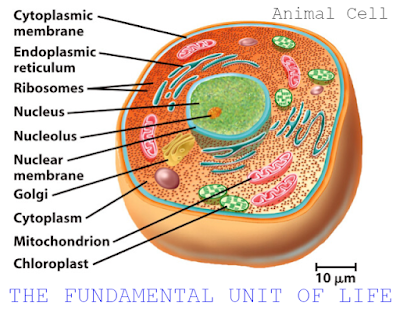CBSE Class 9 - Biology - Cell - Fundamental Unit Of Life - 1 Marker Questions
 |
| Animal Cell (Image Credits: AJC1, Flickr) |
Q1. Name the cell organelle which is commonly called the ‘suicidal bag’ of the cell.
Q2. Which cell organelle is termed the ‘powerhouses’ or ‘storage batteries’ of the cell?
Q3. Name the cell organelles having a double-membrane envelope.
Q4. Name the organelle which is associated with protein synthesis.
Q5. Which organelle of a plant cell has chlorophyll pigments in it?
Q6. Who proposed the fluid mosaic model of the structure of the plasma membrane?
Q7. Who coined the term ‘cell’ and in which year?
Q8. Name the scientists who proposed ‘cell theory.
Q9. Do plants reveal the phenomenon of endocytosis?
Q10. The cell wall is chiefly composed of which material in plants?
Q11. The study of cells is called ________
Q12. Give two examples of unicellular organisms.
Q13. Name the longest human body cell.
Q14. Name the process by which CO₂ or O₂ gets transported across the plasma membrane.
Q15. Name the membrane which covers the vacuole in a plant cell.
Q16. Name two types of endoplasmic reticulum present in the cells.
Q17. What will happen when human red blood cells are placed in a hypertonic salt/sugar solution?
Q18. What will happen when human red blood cells are placed in a hypotonic salt/sugar solution?
Q19. Name the phenomenon that results in the shrinkage of human red blood cells when they are placed in a hypertonic salt/sugar solution.
Q20. Name the carrier proteins that help in the transport of specific materials across the plasma membrane.
Q21. Is the plant cell wall living or dead ?.
Q22. Give two examples of cells where cell shape changes frequently.
Q23. Define osmosis.
Q24. Define diffusion.
Q25. Define cell.
Q26. Where are genes located?
Q27. Give the full form of ATP.
Q28. Where are the ribosomes synthesised?
Q29. Which of the following processes requires energy in the form of ATP?
(a) Active transport, (b) osmosis, (c) diffusion.
Q30. Who coined the term 'protoplasm'?
Q31. Who discovered the first living cell?
Q32. What statement did Virchow add in cell theory?
Q33. Name the source of illumination in an electron microscope.
Q34. Name the single-celled marine alga which is about 10 cm long.
Q35: Give an example of an un-nucleated cell.
Q36: Give an example of skeletal muscle cells.
Q37: What are the two exceptions to the cell theory?
Q38: In which type of cell division do the daughter cells have half the DNA set of that of the mother cells?
Q39: To promote repair, growth and development, cells are divided by ______.
Q40: What is the primary function of leucoplasts?
No comments:
Post a Comment
We love to hear your thoughts about this post!
Note: only a member of this blog may post a comment.